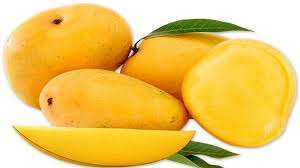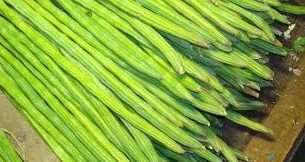The following page describes everything about Mango fruit. It tells what is Mango meaning, and what do we call Mango in Hindi. Some hidden facts also like the health benefits of Mango dry fruit and much more. This page describes facts about Mango. It tells Value of Mango fruit including Minerals and Vitamins in Mango fruit and describes what are the natural benefits and curative properties of Mango with Health Benefits of Mango.
Mango
Botanical Name/Scientific Name: Mangifera indica
Indian Name: Aam
Description of Mango Fruit
The mango enjoys a unique status among the fruits. It is the most popular fruit of the tropics and is called The King of Asiatic fruits’. It is regarded as a valuable item of diet and a household remedy. The mango is fleshy drupe, variable in size and shape, with varying mixtures of green, yellow and red colour. Inside the fruit is stony endocarp, variable in size. Mango grows on a large, erect, branched, evergreen tree. The leaves, when fully grown, are stiff, pointed and deep glossy green. These are used in ceremonial decorations. The dry twigs are used to light sacred fires. The worst types of mangoes are very fibrous with turpentine flavour, but the best are juicy, sweet, with very little fibre and a deliciously piquant flavour.
Origin and Distribution of Mango Fruit
The mango is indigenous to India. It has been cultivated here for over 4000 years. In Vedas, mango is praised as a heavenly fruit. In Hindu mythology; it is believed that when Lord Shiva and Parvati rate from the Himalayas, they raised this heavenly fruit. Parvati who was very fond of mango requested her husband to create a mango tree by his Divine Power. Lord Shiva fulfilled her desire and mango appeared in India. Alexander and his army were the first Europeans who saw mango fruit in India in 327 BC. It was probably taken to Malaya and neighbouring East Asian countries by Indians in the fifth century BC and to the East African coast by Persians about 10th century AD. Besides India, the fruit is now widely grown in China, Pakistan, Bangladesh, Philippines, Haiti, Mexico and Brazil. Numerous varieties are cultivated. In India alone, there are over 500 varieties, but only about 35 varieties are extensively cultivated.
Value of Mango Fruit
The mango is used as food in all stages of its development. Green or unripe mango contains a large portion of starch which gradually changes into glucose, sucrose and maltose as the fruit begins to ripe. It disappears completely when the fruit is fully ripe. Green mango is a rich source of pectin which gradually diminishes after the formation of the stone. Unripe mango is sour in taste because of the presence of oxalic, citric, malic and succinic acids. The raw mango is a valuable source of vitamin C. It contains more vitamin C than half-ripe or fully ripe mangoes, It is also a good source of vitamin B1 and B2 and contains sufficient quantity of niacin. These vitamins differ in concentration in various varieties during the stages of maturity and environmental conditions. The ripe fruit is very wholesome and nourishing. The chief food ingredient of mango is sugar. The acids contained in the fruit are tartaric acid and malic acid, besides a trace of citric acid. These acids are utilised by the body and they help to maintain the alkali reserve of the body.
Mango Food Value
Moisture in Mango 81.0%
Protein in Mango 0.6%
Fat in Mango 0.4%
Minerals in Mango 0.1%
Fibre in Mango 0.7%
Carbohydrates in Mango 16.9%
100%
Minerals and Vitamins in Mango Fruit
Calcium in Mango 14 mg
Phosphorus in Mango 16 mg
Iron in Mango 1.3 mg
Vitamin C in Mango 16.0%
Small amount of Vitamin B Complex
Calorific Value -74
(Values per 100 gms edible portion International Unit)
Natural Benefits of Mango and Curative Properties of Mango
The mango is well-known for its medicinal properties both in unripe and ripe states. The unripe fruit is acidic, astringent and antiscorbutic. The skin of the unripe fruit is astringent and stimulant tonic. The bark is also astringent and has a marked action on mucous membranes.’ Mango pickles preserved in oil and the salted solution is used throughout India. llownet, these pickles, iI extremely sour, spicy and oily, are not good tor health and should be sped Tally avoided by those suffering arthritis. rheumatism, sinusitis, sore throat and hyperacidity. The ripe mango is antiscorbutic, diuretic, laxative, invigorating, fattening and astringent. It tones up the heart muscle, improves complexion and stimulates the appetite. It increases the seven body nutrients, called `dhatus’ in Ayurveda. They are food juice, blood, flesh, fat, bone marrow and semen. The fruit is beneficial in liver disorders, loss of weight and other physical disturbances.
Mango has wonderful health benefits in Treatment of Heat Stroke, Bilious Disorders, Blood Disorders, Scurvy, Eye Disorders, Infections, Loss of Weight, Diabetes, Diarrhoea, Female Disorders, Throat Disorders, Scorpion Bites. To read more about them click the link below-
Click Here for Amazing Health Benefits and Curative Properties of Mango

